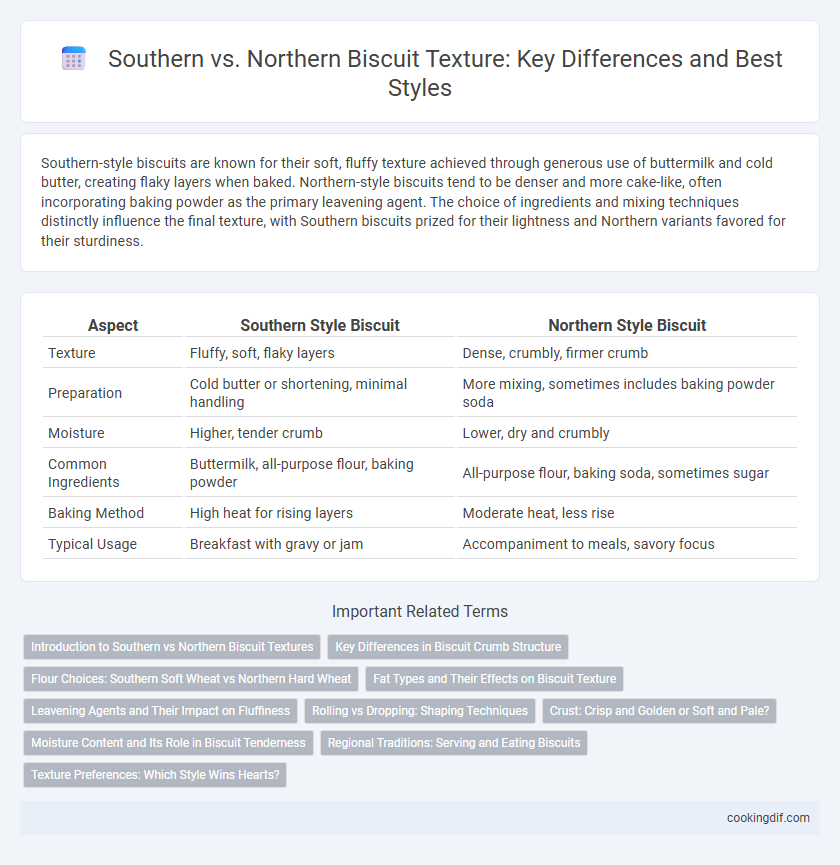Southern-style biscuits are known for their soft, fluffy texture achieved through generous use of buttermilk and cold butter, creating flaky layers when baked. Northern-style biscuits tend to be denser and more cake-like, often incorporating baking powder as the primary leavening agent. The choice of ingredients and mixing techniques distinctly influence the final texture, with Southern biscuits prized for their lightness and Northern variants favored for their sturdiness.
Table of Comparison
| Aspect | Southern Style Biscuit | Northern Style Biscuit |
|---|---|---|
| Texture | Fluffy, soft, flaky layers | Dense, crumbly, firmer crumb |
| Preparation | Cold butter or shortening, minimal handling | More mixing, sometimes includes baking powder soda |
| Moisture | Higher, tender crumb | Lower, dry and crumbly |
| Common Ingredients | Buttermilk, all-purpose flour, baking powder | All-purpose flour, baking soda, sometimes sugar |
| Baking Method | High heat for rising layers | Moderate heat, less rise |
| Typical Usage | Breakfast with gravy or jam | Accompaniment to meals, savory focus |
Introduction to Southern vs Northern Biscuit Textures
Southern biscuits are renowned for their flaky, tender layers achieved through the use of cold butter and buttermilk, creating a light and airy texture favored in comfort food. Northern-style biscuits tend to be denser and more cake-like, often made with baking powder and milk, resulting in a firmer bite and less flakiness. Texture differences arise primarily from ingredient choices and mixing techniques, influencing moisture content and crumb structure in each regional variation.
Key Differences in Biscuit Crumb Structure
Southern biscuits are characterized by a tender, flaky crumb structure achieved through the use of cold butter or shortening and minimal mixing, resulting in distinct, layered pockets of air. Northern-style biscuits typically have a denser, cake-like crumb due to higher liquid content and more thorough mixing, which creates a uniform, fine texture. The key difference lies in the fat incorporation method and mixing technique, directly influencing the biscuit's flakiness and softness.
Flour Choices: Southern Soft Wheat vs Northern Hard Wheat
Southern biscuits are typically made with soft wheat flour, which has lower protein content, resulting in a tender, flaky texture ideal for melt-in-your-mouth softness. Northern biscuits use hard wheat flour, higher in protein and gluten, producing a denser, chewier crumb that holds shape well. The distinct flour types fundamentally influence biscuit texture, with Southern soft wheat promoting lightness and Northern hard wheat providing sturdiness.
Fat Types and Their Effects on Biscuit Texture
Southern-style biscuits typically use cold, solid fats like butter or shortening, which create flaky layers by trapping steam during baking. Northern-style biscuits often incorporate softer fats such as oil or melted butter, resulting in a denser, cake-like texture. The choice of fat directly influences the biscuit's crumb structure and tenderness, with solid fats promoting flakiness and softer fats yielding a moister, more uniform crumb.
Leavening Agents and Their Impact on Fluffiness
Southern-style biscuits typically use buttermilk and baking powder or baking soda as leavening agents, producing a tender, flaky, and fluffy texture due to the acidic reaction with buttermilk that releases carbon dioxide quickly. Northern-style biscuits often rely on baking powder alone, resulting in a denser, crumbly texture because this single-acting leavening agent produces a steadier rise without the extra lift from acid-base reactions. The choice and combination of leavening agents directly influence biscuit fluffiness, with Southern recipes favoring a lighter, airier crumb through faster, more vigorous leavening chemistry.
Rolling vs Dropping: Shaping Techniques
Southern-style biscuits feature a flaky, tender texture achieved through the rolling and cutting method, which creates distinct layers by folding the dough multiple times. Northern-style biscuits typically have a denser, cake-like crumb due to the dropping technique, where batter is spooned or scooped onto baking sheets without shaping. The rolling process promotes flakiness by preserving butter pockets, while dropping results in a softer, less structured biscuit.
Crust: Crisp and Golden or Soft and Pale?
Southern-style biscuits feature a crisp, golden crust achieved through baking at higher temperatures with butter or lard, resulting in a flaky exterior. Northern-style biscuits tend to have a soft, pale crust due to lower baking temperatures and the use of baking powder, producing a tender, cake-like texture. The differing crust textures highlight regional preferences in biscuit preparation and ingredient choices.
Moisture Content and Its Role in Biscuit Tenderness
Southern-style biscuits typically have higher moisture content, resulting in a tender, flaky texture due to increased steam during baking. Northern-style biscuits usually possess lower moisture, producing a denser, crumbly consistency that is less reliant on steam for rise. Moisture content directly influences gluten development and tenderness, making it a critical factor distinguishing biscuit textures across regions.
Regional Traditions: Serving and Eating Biscuits
Southern-style biscuits are known for their flaky, tender texture achieved by layering cold butter and folding the dough multiple times, often served warm with butter, honey, or gravy during breakfast. Northern-style biscuits tend to be denser and more cake-like, frequently used as a base for dishes like chicken pot pie or topped with sweet fillings. These regional traditions reflect distinct culinary preferences, with Southern biscuits emphasizing buttery softness and Northern biscuits favoring sturdiness for versatile serving options.
Texture Preferences: Which Style Wins Hearts?
Southern biscuits boast a tender, flaky texture achieved through cold butter and buttermilk, appealing to those who cherish a melt-in-the-mouth experience. Northern-style biscuits often feature a denser, cake-like crumb favored for heartier bites and durability in breakfast sandwiches. Texture preferences vary, with Southern biscuits winning hearts for softness and flakiness, while Northern biscuits attract fans of a sturdier, less delicate structure.
Southern vs Northern style for biscuit texture Infographic

 cookingdif.com
cookingdif.com